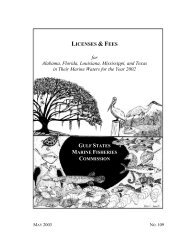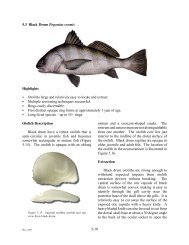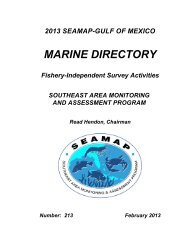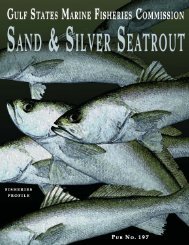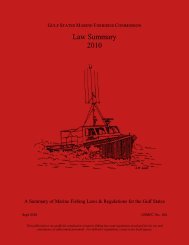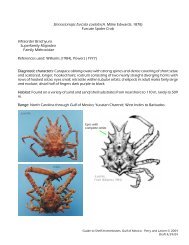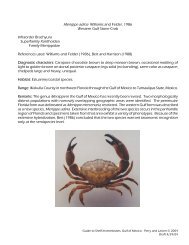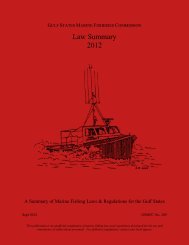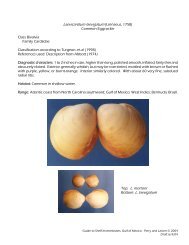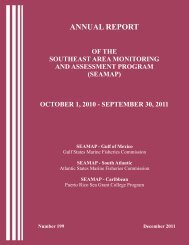Guidelines for Marine Artificial Reef Materials, Second Edition
Guidelines for Marine Artificial Reef Materials, Second Edition
Guidelines for Marine Artificial Reef Materials, Second Edition
You also want an ePaper? Increase the reach of your titles
YUMPU automatically turns print PDFs into web optimized ePapers that Google loves.
• Vessels, due to high vertical profile, attract both pelagic and demersal fishes. Vertical<br />
surfaces produce upwelling conditions, current shadows, and other current speed and<br />
direction alterations that are attractive to schooling <strong>for</strong>age fishes, which in turn attract<br />
species of commercial and recreational importance, resulting in increased catch rates <strong>for</strong><br />
fishermen.<br />
• Vessels, like other artificial reef material, can augment benthic structure which locally<br />
increases shelter opportunities and reef fish carrying capacity in locations where natural<br />
structure is sparse, or create structure which is more preferable or attractive to certain fish<br />
species than locally less complex hard bottom (Barnette 2001).<br />
• Steel-hulled vessel reefs that are not well publicized, located far offshore, or otherwise<br />
difficult to access <strong>for</strong> fishing and diving because of depth and currents may, if properly sited,<br />
provide important refuge <strong>for</strong> reef fish species. Such vessels can provide important<br />
aggregation, shelter, and residence sites <strong>for</strong> reef fish species that have been traditionally<br />
over-fished such as warsaw, black, goliath grouper, red snapper, amberjack, and others.<br />
• Vessels under certain conditions may provide habitat <strong>for</strong> spawning aggregations of some<br />
managed reef fishes [e.g. greater amberjacks on wrecks off Broward County (SE Florida],<br />
goliath grouper on wrecks off SW Florida.<br />
• Vessels may provide extensive surface area <strong>for</strong> epibenthic colonization. This colonization<br />
results in the enhancement of lower trophic level biomass at the vessel site.<br />
• Under some circumstances, depending on location and season, some vessels may hold<br />
greater abundances and higher biomass of fish species, including some recreationally<br />
important species (i.e. gray snapper), than nearby natural reefs (Spieler 2001, Palm Beach<br />
County DERM 2001).<br />
• Vessels may reduce anchor damage and other physical damage by directing a proportion of<br />
the reef users away from nearby natural reefs. In Southeast Florida, about 1/3 of the fishing<br />
use is on artificial reefs, with many of these reefs vessels; 2/3 of the reef use is on natural<br />
reefs (Hazen and Sawyer Associates 2001). Similarly, vessels provide diving alternatives to<br />
natural reef sites where physical damage to natural reefs through anchor damage, grounding,<br />
handling, crawling on, specimen collecting, and spear fishing have accelerated deterioration<br />
of natural reefs and their associated fauna.<br />
• Sinking a vessel often creates a media event, providing reef managers with promotional<br />
opportunities <strong>for</strong> their reef programs.<br />
• Sinking steel-hulled vessels as artificial reefs, properly cleaned and under appropriate<br />
conditions may assist other agencies and programs (permanent removal of drug seized<br />
vessels from the drug trade, elimination of derelict vessels that have become navigation or<br />
safety hazards, etc.).<br />
-33-



